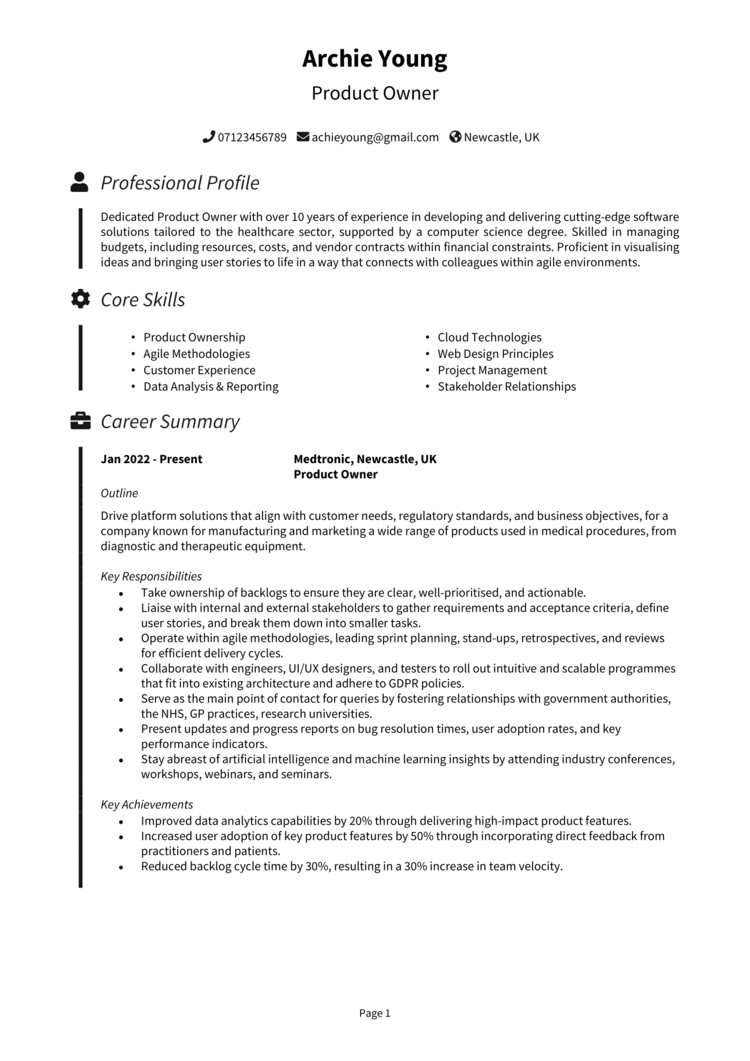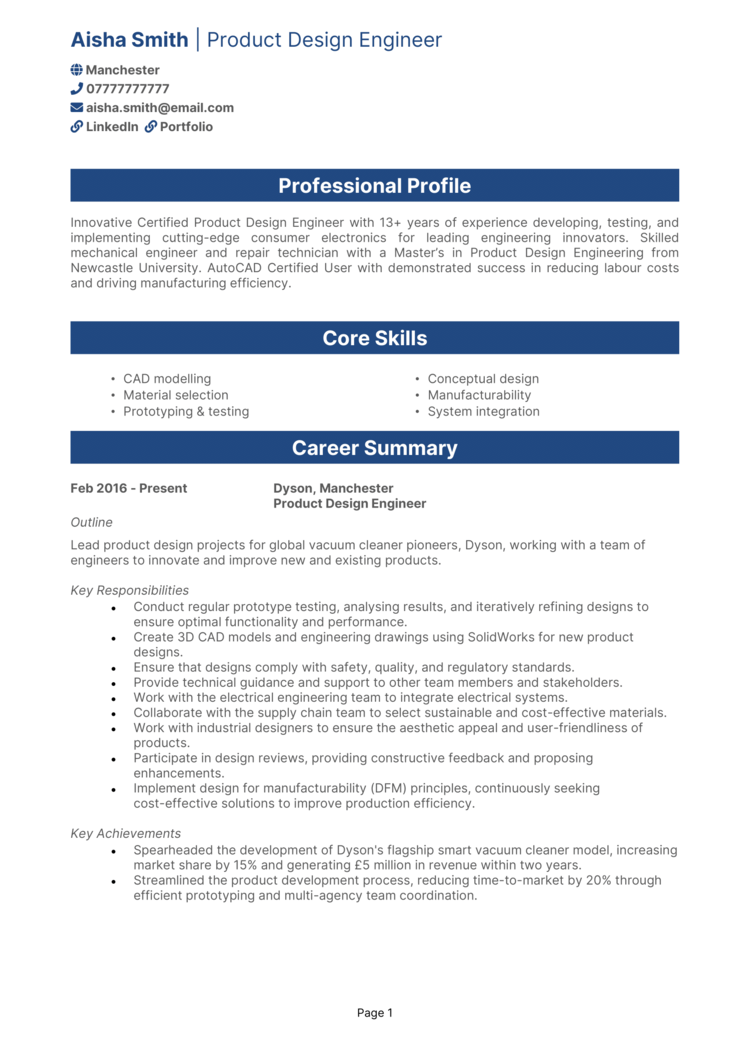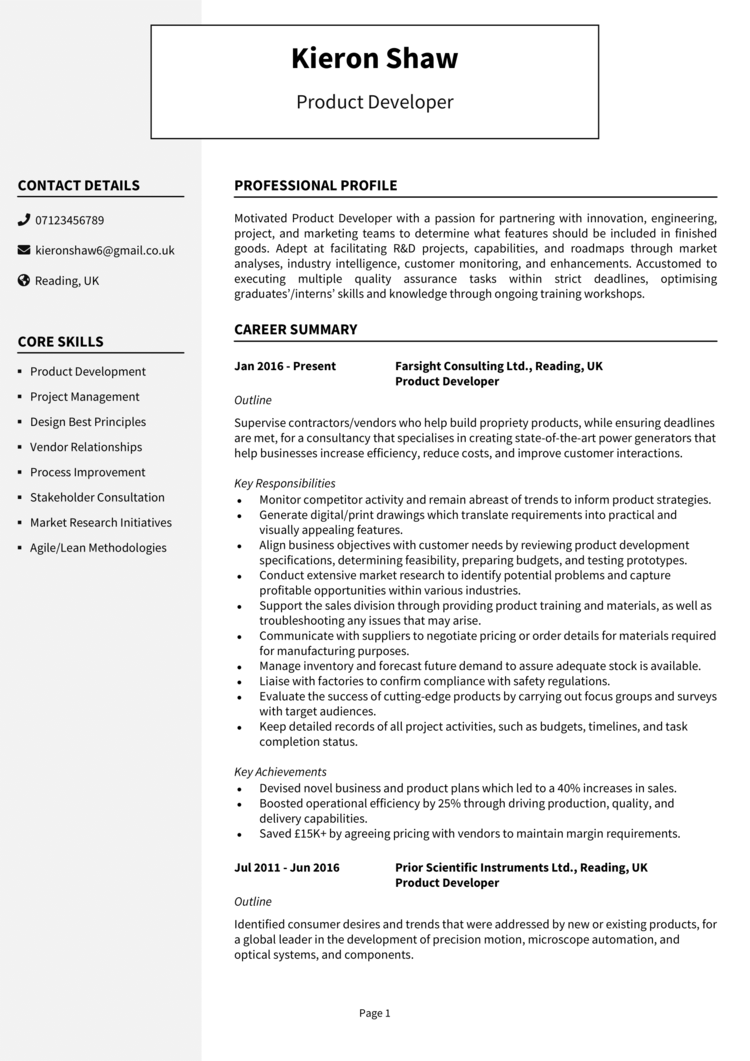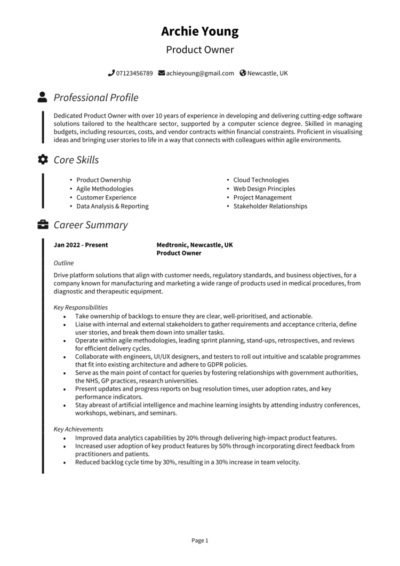Before you can optimise workflows and define sprint goals, you need to get hired first.
Think of your CV like a product backlog – if it’s cluttered and unorganised, recruiters will ignore the important features and move on to the next release (a.k.a. another candidate).
This guide, with 4 Product Owner CV examples, will show you how to craft a CV that highlights your strategic thinking and stakeholder collaboration skills.
Product Owner CV

Product Manager CV

Product Design Engineer CV

Product Developer CV

How to write your Product Owner CV
Learn how to create your own interview-winning Product Owner CV with this simple step-by-step guide.
A Product Owner needs to be clear, strategic, and results-driven – and so does your CV. You only have a couple of pages to show recruiters why you’re the best person to own their product vision and drive business success.
This guide will walk you through how to structure and format your CV, highlight your agile expertise, and position yourself as the ideal candidate for any product team. By the time you’re done here, everything in your CV will be more user-friendly than the latest app update (minus the inevitable bugs).
Product Owner CV structure


Your CV needs to be as structured as your product backlog, with the same clear priorities and lack of unnecessary fluff.
The goal? A recruiter should be able to scan it as effortlessly as a well-designed Jira board – clean, intuitive, and frustration-free. A competent CV layout will let recruiters easily see why you’re the best fit.
Here’s how to structure your Product Owner CV:
- Name and contact details – Put your personal details at the top, along with a photo of yourself if you want – but that part is optional.
- Profile – Start things off with a concise snapshot of your product ownership experience and core strengths, and the value you’ll bring to the recruiter’s company.
- Core skills – Highlight your expertise in agile frameworks, backlog prioritisation, and stakeholder management: tailor these to the specific job.
- Work experience – Detail your roles in reverse chronological order, showing how you’ve delivered value.
- Education – Outline your degrees, certifications, and any relevant training.
- Additional info – You’re also able to mention hobbies and interests that demonstrate leadership and teamwork, as well as things like awards you’ve earned.
Product Owner CV format


Think of your CV as your MVP – your Minimum Viable Presentation, that is. No unnecessary features, just sleek formatting that makes recruiters’ lives easier. Your CV format should be easy to scan, professional, and structured to highlight your strengths.
Follow these helpful tips for your formatting:
- Bullet points – Keep sentences concise and impactful, using bullet points to organise responsibilities.
- Divide sections – Use clear headings to make navigation simple for busy recruiters.
- Use a clean font – Along with an appropriate colour scheme, ensure your font is easy for the recruiter to read.
- Keep it the right length – Stick to a two-page length limit to highlight your key achievements without unnecessary extras.
Product Owner CV profile


Your profile (or your personal statement, if you’ve got less experience) is your elevator pitch – a short, compelling summary that sells you as the best Product Owner for the role. Keep it brief but impactful, focusing on your experience, key skills, and career highlights. The fundamental goal is to convince recruiters of the benefits of hiring you.
Product Owner CV profile examples
Profile 1
Strategic Product Owner with four years of experience in Agile environments, driving the development of customer-centric digital products. Skilled in backlog management, stakeholder collaboration, and translating business needs into actionable user stories. Experienced in using Jira, Confluence, and A/B testing tools to optimise product functionality. Passionate about improving user experiences and delivering business value through iterative improvements.
Profile 2
Detail-oriented Product Owner with three years of experience in e-commerce, specialising in feature development, roadmap planning, and user story refinement. Adept at working with cross-functional teams to deliver scalable and high-performing digital solutions. Proficient in Agile methodologies, wireframing tools like Figma, and analytics platforms such as Google Analytics and Hotjar.
Profile 3
Experienced Product Owner with over six years of expertise in software development projects, focusing on aligning business goals with technical execution. Skilled in prioritising product backlogs, defining KPIs, and leading Agile ceremonies. Proficient in Jira, Azure DevOps, and API integrations to enhance product capabilities and user engagement.
What to include in your Product Owner CV profile
Here are some tips on what to include in your Product Owner CV profile:
- Where you’ve worked – Mention the industries or companies you’ve worked with, especially those relevant to the role.
- Your top qualifications – Highlight certifications like Certified Scrum Product Owner (CSPO) or SAFe PO/PM.
- Essential skills – Include things like backlog management, stakeholder engagement, and agile methodologies.
- Products you’ve helped with – Make a note of software, apps, or platforms you’ve contributed to.
- Tools you’ve mastered – Definitely mention specialist software knowledge, like Jira, Confluence, Aha!, or other product management tools.
Core skills section


Your core skills section gives recruiters a quick snapshot of your abilities. Think of this section as your feature list – highlight the absolute essentials, and leave out anything that doesn’t contribute to product (or career) success: rather than making the mistake of listing every skill under the sun, focus on your most valuable and relevant strengths.
When writing a CV, you should tailor the skills you mention to the job. If the role emphasises B2B SaaS products, include skills in your CV like enterprise customer engagement. If it’s for an e-commerce company, focus on A/B testing and conversion optimisation.
Key skills for a Product Owner CV
- Product Roadmap Development – Defining and prioritising product goals, features, and milestones to align with business objectives.
- Backlog Management – Creating, refining, and prioritising the product backlog to ensure development teams focus on high-value tasks.
- Stakeholder Communication – Collaborating with executives, developers, and customers to gather requirements and align expectations.
- User Story Writing – Crafting clear and concise user stories and acceptance criteria for development teams.
- Agile Methodology – Applying Scrum, Kanban, or SAFe frameworks to drive iterative product development.
- Market and Competitor Analysis – Conducting research to identify trends, opportunities, and competitive positioning.
- Data-Driven Decision Making – Using analytics and customer feedback to prioritise features and measure product success.
- Sprint Planning – Working with Scrum teams to plan sprints, allocate resources, and ensure timely delivery.
- User Experience Optimisation – Ensuring product design and functionality meet customer needs and enhance usability.
- Risk Management – Identifying potential risks in product development and implementing mitigation strategies.
How to highlight work experience


Your work experience section is where you prove your impact. Recruiters want to see how you’ve owned and delivered successful products, worked with development teams, and contributed to business growth.
Your work experience section should tell a story – think of it as a case study proving why you’re the go-to expert for delivering results.
List your roles in reverse chronological order, starting with your most recent position. Keep descriptions concise but informative, focusing on measurable results.
How to make your past experience easy to read for employers

- Outline – Briefly describe the company, your role within it, and the products you managed.
- Responsibilities – Focus on key tasks, such as defining product roadmaps, collaborating with developers, and gathering stakeholder feedback. Use action verbs like “prioritised,” “launched,” or “streamlined.”
- Achievements – Show measurable impact, using numbers whenever possible to quantify your success..
Work history examples for a Product Owner CV
Product Owner | ABC
Outline
Managed the product backlog and defined user stories for a SaaS platform, ensuring alignment with business objectives and customer needs.
Responsibilities
- Collaborated with stakeholders to define product requirements and prioritise features.
- Created and refined user stories, acceptance criteria, and epics in Jira to guide development teams.
- Worked closely with UX designers to develop wireframes and prototypes for new features.
- Monitored product performance using Google Analytics and customer feedback tools.
- Led sprint planning and backlog grooming sessions to ensure development efficiency.
Achievements
- Increased platform adoption by 30 percent through data-driven feature enhancements.
- Reduced development cycle time by 20 percent by improving backlog refinement processes.
- Recognised by leadership for delivering a key product update ahead of schedule.
Product Owner | ABC
Outline
Owned the product roadmap for an e-commerce platform, ensuring seamless customer experiences and optimising conversion rates.
Responsibilities
- Defined and managed the product roadmap, aligning development priorities with business goals.
- Collaborated with development teams to deliver new features and improve site performance.
- Conducted A/B testing to refine UX designs and improve customer engagement.
- Analysed user behaviour through Hotjar and Google Analytics to identify opportunities for optimisation.
- Coordinated with marketing and sales teams to align product updates with promotional strategies.
Achievements
- Increased checkout conversion rates by 15 percent through targeted UI/UX improvements.
- Delivered a new personalised recommendation engine, boosting average order value by 10 percent.
- Streamlined feature release cycles, reducing time-to-market by 25 percent.
Product Owner | ABC
Outline
Led product development for a digital banking application, focusing on feature innovation, compliance, and user experience improvements.
Responsibilities
- Gathered business and customer requirements to shape the development of financial tools and services.
- Worked with engineering teams to refine technical specifications and prioritise backlog items.
- Ensured compliance with financial regulations by collaborating with legal and risk departments.
- Developed and tracked key product KPIs to measure feature effectiveness and adoption rates.
- Facilitated Agile ceremonies, including sprint planning, retrospectives, and daily stand-ups.
Achievements
- Increased customer retention by 20 percent by introducing a streamlined onboarding process.
- Successfully launched a budgeting tool that improved user engagement by 35 percent.
- Recognised for delivering high-priority features within aggressive regulatory deadlines.
Education section


The education section shows recruiters that you have the necessary academic background and industry certifications.
For Product Owners, degrees in business, computer science, or a related field are valuable. However, certifications in agile methodologies like CSPO, SAFe PO/PM, or PMI-ACP can be just as important.
List your qualifications in reverse chronological order, starting with the most recent. If you’re transitioning into product ownership, mention courses or training that show your commitment to the field.
Qualifications recruiters look for in a Product Owner CV
- Certified Scrum Product Owner (CSPO) – Recognised certification for agile product ownership.
- SAFe Product Owner/Product Manager (PO/PM) – Ideal for enterprise agile environments.
- Professional Scrum Product Owner (PSPO) – Demonstrates strong knowledge of Scrum methodologies.
- PMI Agile Certified Practitioner (PMI-ACP) – Great for showing broader agile expertise.
- Google UX Design Professional Certificate – Useful for Product Owners working closely with UX/UI teams.





